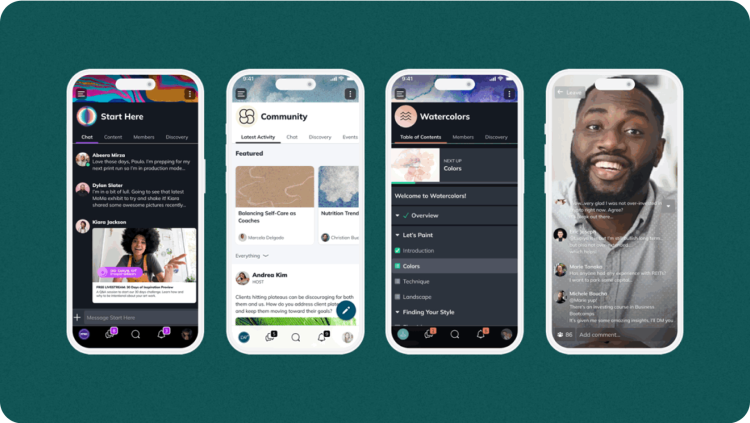Online Courses
The 24 Best Online Learning Platforms for 2025
This is everything you need to know, whether you’re a student, an instructor, or professional, about online learning platforms.
Author
Mighty Team
Last Updated
September 18, 2025

Table of Contents
- 24 Best Online Learning Platforms (Quick Chart)
- 24 Online Learning Platforms
- Top Online Learning Software
- Top Online Learning Plugins
- Institutional Online Learning Platforms
- Branded online learning app software
- Ready to start?
- What is an online learning platform?
- Online Learning Platforms vs. Online Course Platforms
In this article
- 24 Best Online Learning Platforms (Quick Chart)
- 24 Online Learning Platforms
- Top Online Learning Software
- Top Online Learning Plugins
- Institutional Online Learning Platforms
- Branded online learning app software
- Ready to start?
- What is an online learning platform?
- Online Learning Platforms vs. Online Course Platforms
Online learning will hit a value of $62 billion by 2027 and it’s projected that 1 billion people will be using online learning platforms by 2028!
In this article, we’re going to introduce online learning platforms. We’ve packed a lot in, so feel free to jump around to find what you need. This is everything you need to know, whether you’re a student, an instructor, or you’re working with an institution or business.
In this guide:
An overview of online learning platforms, online learning software, and how to tell the difference
The best online learning platforms offering course libraries and subscriptions
The best online learning software and plugins for teachers launching their own hosted course
The best online learning software for educational institutions
24 Best Online Learning Platforms (Quick Chart)
Best Features & Ideal User | Cost for Instructors | Cost for Students | |
|---|---|---|---|
Live & Async Courses, Communities, Events; Ideal for Independent Creators | $109/mo | You Set Prices | |
Cohort-Based Learning, Curated Courses; Ideal for Live Teaching | 10% Revenue Share | Approx $500 | |
Built-In Social Media Integration, Certificates; Ideal for Professionals & Corporate Learners | Revenue Share, $1,000-$5,000 Payout Upfront | Included w/ LinkedIn Premium ($39.99/mo) | |
Course Marketplace, Millions of Learners; Ideal for Exposure | 37%-97% Revenue Share | Varies by Course, Often $10-$50 | |
Nanodegree Programs, Industry Experts; Ideal for Digital Skill Learning | Salaried (Reported ~$70,000) | $249/mo | |
University Courses, Certificates, Degrees; Ideal for Academic & Professional Development | Revenue Share; Requires Uni or Corporate Affiliation | $59/mo for Coursera Plus | |
Creative-Focused, Large Course Library; Ideal for Designers & Creatives | Revenue Share Based on Watch Time | From $14/mo | |
Free Educational Platform, Globally Accessible; Ideal for K-12 & General Learners | N/A | Free | |
MOOCs, University-Level Courses; Ideal for Self-Directed College-Level Learning | Institutional Salaries for Instructors | Free to Audit; Fees for Certificates Vary | |
Corporate Training, AI Practice; Ideal for Upskilling in the Workplace | Institutional Pricing | Institutional Access | |
Hands-On Coding, Learning Paths; Ideal for Aspiring Data Scientists | Salaried Positions for Instructors | $25/mo | |
Funnels, Email Marketing, Pre-Recorded LMS; Ideal for Selling Asynchronous Courses | $149/mo | You Set Prices | |
AI Builder, Marketing Tools, Apps; Ideal for Flexible Course Builders | $24 + $5/Sale | You Set Prices | |
Customizable Builder, Assessments; Ideal for Pre-Recorded Course Programs | $39-$399/mo (Flat Fee) | You Set Prices | |
Affiliate Features, Landing Pages; Ideal for Standalone Courses | $59/mo + 5% Fees | You Set Prices | |
Basic Website Builder, Integrated Marketing; Ideal for Digital Products | $39/mo + 5% Fees | You Set Prices | |
White-Labeled LMS, Flexible Tools; Ideal for Customized Institutional Learning | Custom Pricing | You Set Prices | |
WordPress LMS, Drag-and-Drop Builder; Ideal for WordPress Course Creators | $199/yr | You Set Prices | |
Membership Gating, Payment Features; Ideal for Monetizing WordPress Content | $179-$499/yr | You Set Prices | |
Checkout, Subscriptions, Branding; Monetizing WordPress | $25/mo + Fees | You Set Prices | |
Open-Source LMS, Discussion Forums; Ideal for Institutions w/ IT Teams | Free (Hosting & Plugins Required) | N/A (Institutional) | |
Cloud LMS, Collaboration Tools; Ideal for Schools & Universities | Custom Institutional Pricing | N/A (Institutional) | |
Modules, Assignments, Discussions; Ideal for Institutional Learning | Custom Institutional Pricing | N/A (Institutional) | |
Courses, Communities, and Events on Branded Apps; Ideal for Established Brands and Creators | Learn More Here | You Set Prices |
24 Online Learning Platforms
1. Mighty Networks
Mighty Networks is an online course software that lets you deliver any combination of live or pre-recorded courses under your own brand.
Live teaching with Gen3 native livestreaming for up to 50k attendees, high-velocity chats, Q&As, polls, and a "Backstage" area.
Asynchronous learning with a built-in Table of Contents (LMS) to build a pre-recorded course with text, video, audio, and downloads.
With unmatched engagement on G2's top-rated community management platform.
Mighty Hosts can teach live, create pre-recorded courses, or mix and match (e.g. lots of people teach live and then sell the recording later).

Here's what makes Mighty the best online learning platform:
Customize course spaces
You create custom course spaces, adding and taking away the features you need.
Course spaces can include Discovery Feeds, Event Series or 1-Time Event, Chat & Messaging, Member Lists, Assessments, or Highlighted Hashtags. And you can livestream natively in any space.
This lets you create any kind of online course you want and mix it with any kind of content you want.

Engagement everywhere
Mighty is built for student engagement.
Member explorer that helps students meet each other with profile assist, new student checklists, the "Show Similarities" tool, and instant AI conversation boosts.
Conversations under each course module and alongside a livestream.
Gamification with habit trackers, leaderboards, triggers, and rewards unlocking (e.g. resources or 1:1 calls, secret courses, challenges, ).

More ways to earn money
With Mighty, you can create and sell courses in 135 different currencies. And you can bundle these with things like coaching, masterminds, private groups, premium content, virtual events, and even live conferences.

Easier management
Tools that make it easier to build courses and keep students engaged: think instant course outlines, auto re-engagement for students who haven't been active in a while.
Grow your student community with analytics and data points for your entire business and individual Spaces, with info on member engagement, sales, activity, etc.
Built-in integrations for Kit (AKA ConvertKit) and Zoom, plus 2,000+ embeds of popular software like Figma, Calendly, Loom, and Notion.
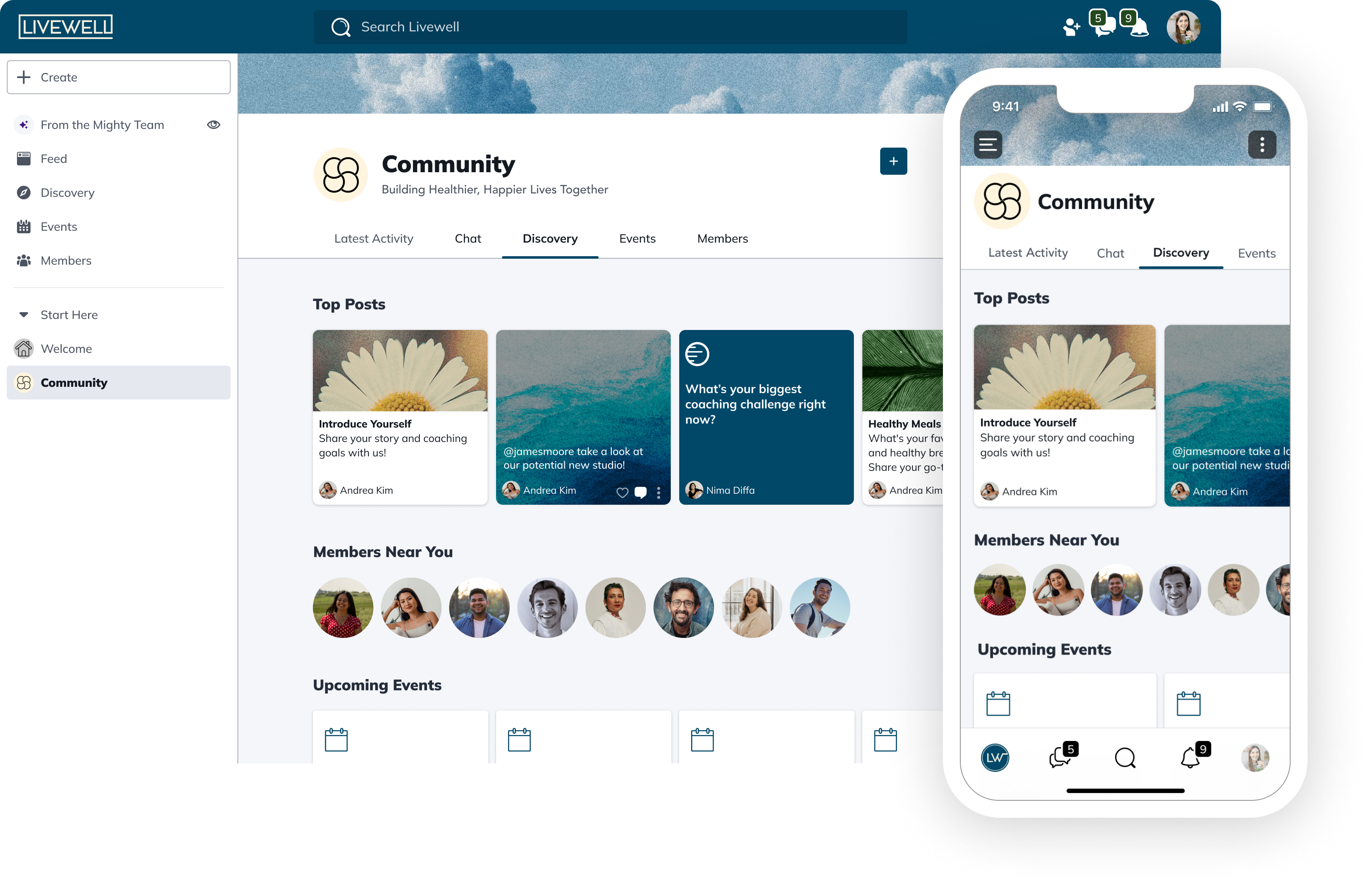
Branding power
Build your course under your brand with custom colors, imagery, light & dark mode, and custom URLs.
Instantly generate a brand identity and landing pages with Mighty Co-Host™.
Comes with access to Mighty Networks apps for every course, OR get your own branded app in the App Store and Google Play Store. (Learn More Here)

Mighty also comes with Mighty Co-Host™ built-in, it’s your AI co-host to help you grow your course business with: instant outlines, landing and sales pages, test assists, icebreaker questions, and more.
Try Mighty Networks free for 14 days.
Pros
Teach in way you want: live, pre-recorded, or mix and match.
Integrate online learning with G2's top-rated community platform for things like virtual events, DM and chats, discussion forums, and member profiles.
Sell courses with pre-payment or plans, and bundle with any combo of coaching, private community, mastermind, event, premium livestreams, and/or premium or bonus content.
See MORE completions and success stories with a platform that's designed for real engagement, helping students learn in community.
Teach your courses under your own brand on your own app.
Cons
It's not built for institutional learning like some of the options below. It's best for independent creators and brands.
It's not a course marketplace platform with existing students. You'll need to grow your own course business.
Best features Mighty can do any kind of online course with engagement tools you won't find anywhere else.
Pricing & payouts Mighty's course pricing starts at $109/mo
2. Maven
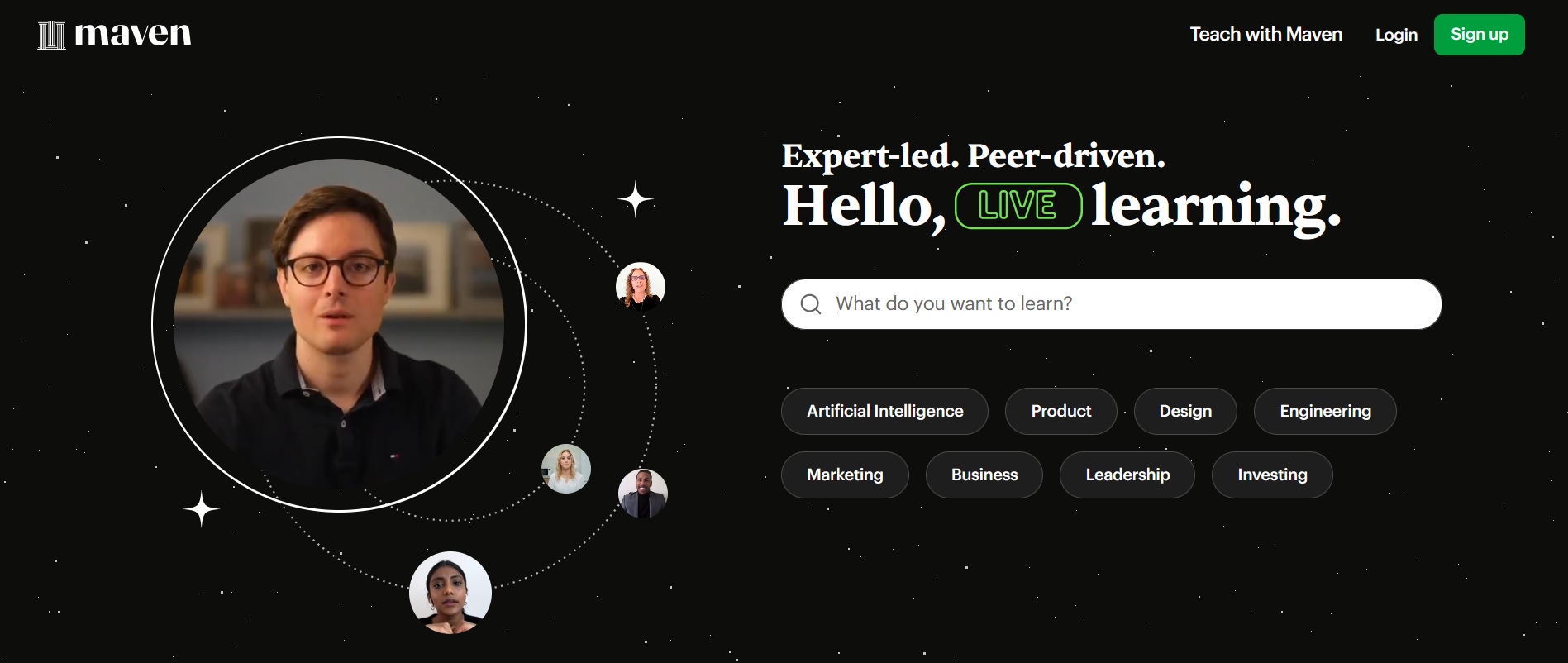
Maven is an online learning platform that focuses on cohort courses. The teachers are all leaders with a proven track record at the thing they’re teaching.
Cohort courses (AKA live learning) are great for student engagement and retention. Students love them.
To teach on Maven, you need to apply and be selected. If you are, Maven gives you access to training, course templates, and a teaching community.
Pros
Curated courses that are offered by practitioners.
Higher margins from live teaching – it functions as a “high-ticket product”
Lots of support for teachers like a teaching community, templates, and training
A course catalog to grow your student base that functions like a course library
Cons
You need to apply to teach and have enough credentials and experience to be approved
Grows Maven’s brand; doesn’t grow your brand
Doesn’t give you passive income or recurring revenue; a cohort course is limited unless you keep teaching
Maven keeps 10% of your revenue
Best features Maven has solved the problem most course marketplaces have–lack of engagement and support. By offering live courses in a marketplace, teachers can earn more and students get a better experience.
Pricing & payouts
Maven doesn’t charge anything upfront but keeps 10% of your revenue. Individual course prices vary, but Maven recommends starting at $500.
3. LinkedIn Learning
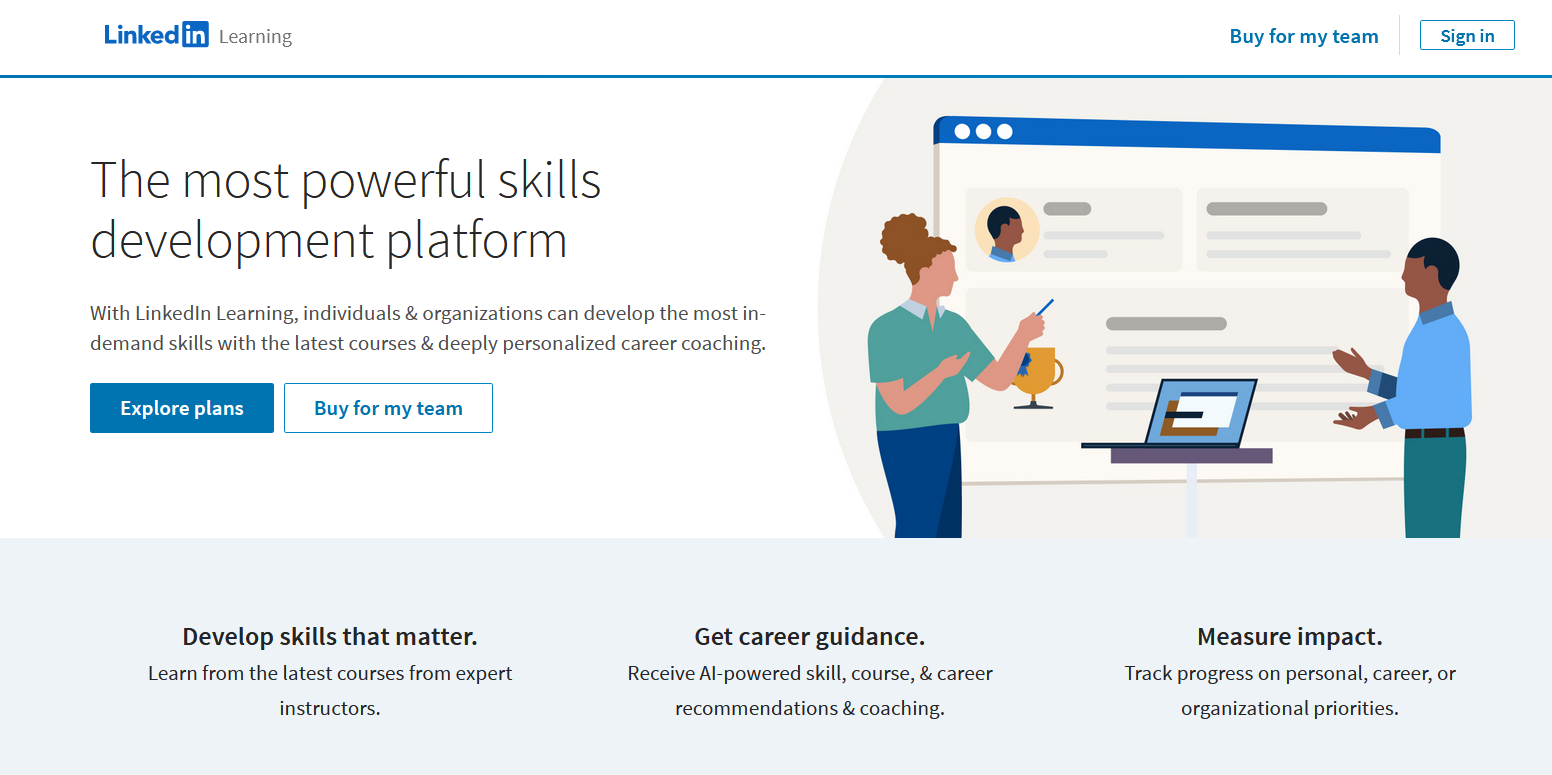
LinkedIn Learning is an online learning platform that comes with LinkedIn Premium--with almost 50 million subscribers. The platform comes with a course-builder, a rating system, and a listing in an enormous course archive of 16,000 courses. This makes LinkedIn learning a solid value proposition for students–especially if they subscribe to LinkedIn anyway.
For instructors, teaching on LinkedIn Learning has a few more challenges. First, it’s another e-learning platform that you’d need to apply and be accepted on. But if you get accepted, you do get support with both course planning and recording to make sure it’s up to their quality.
Pros
An online learning platform built into a social media giant
Easy-to-use LMS with ratings features and good course playback
Certificates of completion – which can be valuable (not always) and link to your profile
If you’re paying for LinkedIn Premium anyway, you might as well use what you have.
Instructors get a social proof and credibility boost from being on LinkedIn
Cons
Need to apply and be approved to teach
Can only teach pre-recorded courses, virtually no options for flexible delivery or different teaching styles
No way to engage with students
Lots of competition for eyeballs with other LinkedIn courses
You don’t own your relationship to your students – LinkedIn does
Best features LinkedIn Learning’s value proposition for students is pretty simple: tons of useful courses that are included with a premium subscription. For instructors, it’s the social proof that comes with acceptance to teach on the platform and the many people you could reach.
Pricing & payouts Payouts from $1,000-$5,000 upfront with a revenue share that depends on course performance.
4. Udemy
Udemy is another online learning platform that comes with a course library, some course-building features, and built-in students on their platform.
But Udemy does something that LinkedIn Learning and Skillshare (below) don’t do. It has a mixed pricing model that lets students buy a single course OR a subscription.
Pros
Course marketplace with 64 million learners and tons of courses
Good course-building features (pre-recorded only) with an easy-to-use editor
Can sell the course to individuals, earning from your following (if you have one) and people who discover it
The apps are great and work for every device
Cons
Udemy keeps 63% of revenue from platform-based students who find your course
No way to teach live courses or add different types of engagement – it’s just a basic, pre-recorded course platform
Minimal ways to contact or communicate with your students
Almost no options to add your own branding or creativity
Best features As far as course marketplaces go, Udemy is one of the better ones for compensating instructors. It lets you keep 97% of the revenue from students that you bring to the website yourself (e.g. from a coupon link).
Pricing & payouts Udemy lets you keep 97% from students you bring in. But for students who find your course via the marketplace or a promotion on Udemy, you only get 37%.
5. Udacity
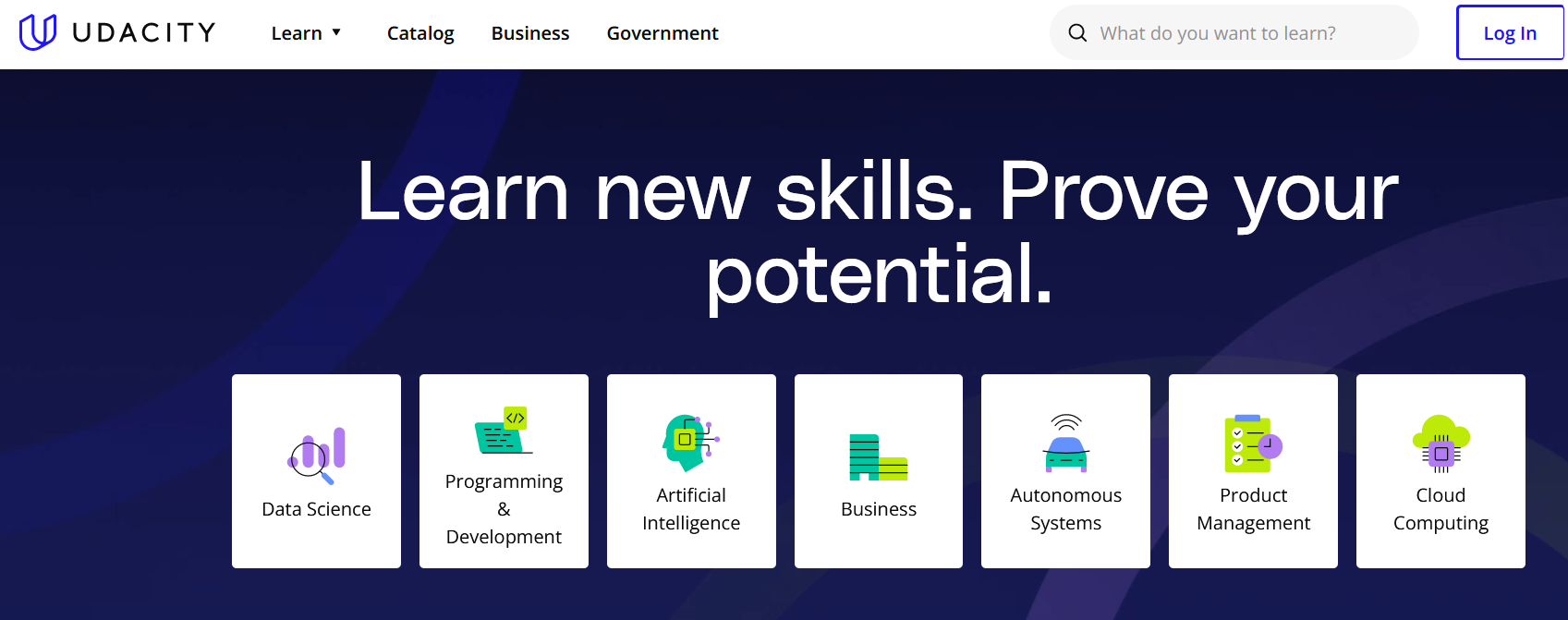
Udacity is an online learning platform that has 80+ nanodegree programs built into it. It has a focus on digital and tech skills, and gives students subscription access to a library of courses.
If you’re a potential teacher, Udacity requires an application–generally, they hand-select their teachers from industry experts. If you are picked as a teacher, there’s a guaranteed compensation that’s paid regardless of how many students take the course.
Pros
Industry-relevant courses taught by experts in different fields with credentialing.
Mentors provide support for students through their learning journeys and they produce real-world projects that can be used for a portfolio.
The learning is boosted by a community feature where students can meet other learners and teachers.
Options for team or corporate-based learning in group subscriptions.
Cons
For students, it’s an expensive membership ($249/mo).
For teachers, there’s no guarantee of even being accepted (In fact, with only 250 courses, most teachers aren’t).
Only a narrow selection of fields are represented.
Self-directed learning can be tough. There are some features to boost accountability, but it’s still on the learner to keep motivated.
No mobile course apps - an enormous miss for a platform focusing on tech skills
Pricing & payouts For students:
$249/mo (library access)
$846 (4 month subscription)
It’s difficult to know exactly how much they pay instructors, but several salary sites report around $70,000. (But keep in mind, most instructors are active in other fields too, and not full-time on Udacity.)
6. Coursera
Coursera is an online learning platform that’s integrated with higher ed; people can take college credits and even do entire degrees on Coursera.
For teachers, unless you have an affiliation with a major university or tech company (e.g. Google), it’s unlikely you’ll be able to teach on Coursera.
However, if you are, you get access to a whole teachers’ portal with resources, training, and content assistance. And, unlike other platforms, Coursera’s certificates are universally recognized.
Pros
A course marketplace with teachers from top companies and educational institutions
Good support for teachers
Huge user base (129 million users)
Accreditations and certificates that are well-recognized and mean something (most learning platforms offer certificates, but they aren’t from top schools and businesses)
Cons
Only open to academic institutions or major companies
It still focuses on pre-recorded courses
Best features
A huge selection of courses by leading experts from companies and academia–with accreditations that count.
Pricing & Payouts Coursera has a “Coursera Plus” plan that gives you access to 90% of their courses for either $59/mo or $399/yr. If they want official certifications (e.g. a college credit), students need to pay the proper tuition.
7. Skillshare
Skillshare has an enormous course collection (34,000) with millions of learners–and it’s exceptionally strong for creative courses taught by the best designers, photographers, illustrators, etc.
Skillshare does require an application to teach, but they do seem to have a lower bar for acceptance than other learning platforms. As a result, the course reviews become even more important for potential students to judge courses, but fortunately the system works well.
One cool feature of Skillshare is its project feature that lets instructors and fellow students give feedback.
Skillshare’s revenue share model is arguably one of the worst for instructors, though. They divvy up part of their revenue into a large pot and distribute it to creators by watch time. If your course doesn’t get a large viewership (something you don’t control), you may not earn much.
Pros
Course marketplace with a good content delivery platform and decent LMS
Strongest for creatives
Good “project” features to encourage some engagement and collaborative learning
Good apps for all devices
Cons
More lower-quality courses because it’s not well vetted
Poor revenue share for instructors based on course watch time
Lots of competition for eyeballs
No other ways to teach (e.g. live instruction)
Best features As above, the best features of Skillshare is the strong representation of creatives in the courses.
Pricing & payouts For students, Skillshare comes with a free month and after that costs $32/mo or $168/yr. For instructors, payouts are determined by watch time and divided accordingly.
8. Khan Academy

Khan Academy is a non-profit online learning platform that allows students to learn just about anything. It was founded by Sal Khan with a vision for democratizing education, with courses in math, science, humanities, arts, etc. Khan Academy has a personalized approach to learning, so students can go at their own pace and find gaps in their knowledge to fill.
Khan Academy hand picks its teachers, so if you want to launch an online course, it’s not the platform for you. It’s best for existing teachers and tutors looking to fill out course material with blended learning.
Pros
It’s free and accessible around the globe and has courses for every level–from Pre-K to college, largely thanks to a donor base that supports it.
Good tools for both students and teachers to collaborate and create learning plans.
High-quality course content created by experts. Teachers can create and build tons of existing content into their classrooms.
It’s based on an amazing vision to provide education to kids around the world.
Cons
The user interface can be confusing and messy, with different kinds of teaching materials to incorporate into your class.
There are some reported technical support issues among users who have struggled to get help.
Best features Khan Academy is best for teachers and students in an existing k-12 or higher ed classroom who want to augment what they’re teaching with ready-made material.
Pricing & Payouts
Free to use
9. EdX

EdX is an online learning platform that was created in a partnership between MIT and Harvard in 2012. It hosts Massive Open Online Courses (MOOCs) from major colleges and universities.
For potential teachers, EdX posts jobs much like any other company; you need to apply to an open position to teach a course.
Pros
Students can access the best courses from top universities around the world making for high-quality content.
Access to university and college courses for those who might not be able to learn from them otherwise.
Lots of free course options, but you pay if you choose a credential.
Instructors get a global reach for teaching as well as a paycheck (like a normal job)
EdX has useful content and course creation tools to work with, and can incorporate quizzes, discussion forums, and peer assessments.
Cons
Students get limited access to teachers (if any) for help and support. It’s self-directed.
Most courses are free to audit, but you’ll need to pay more if you want a credential or certificate (similar to Coursera).
Learners need to understand which prerequisite courses are needed before jumping into a course.
Best features EdX is great for self-directed learners who want access to university and college-level courses for free
Pricing & payouts
Free to audit, but certificate pricing varies
10. Skillsoft
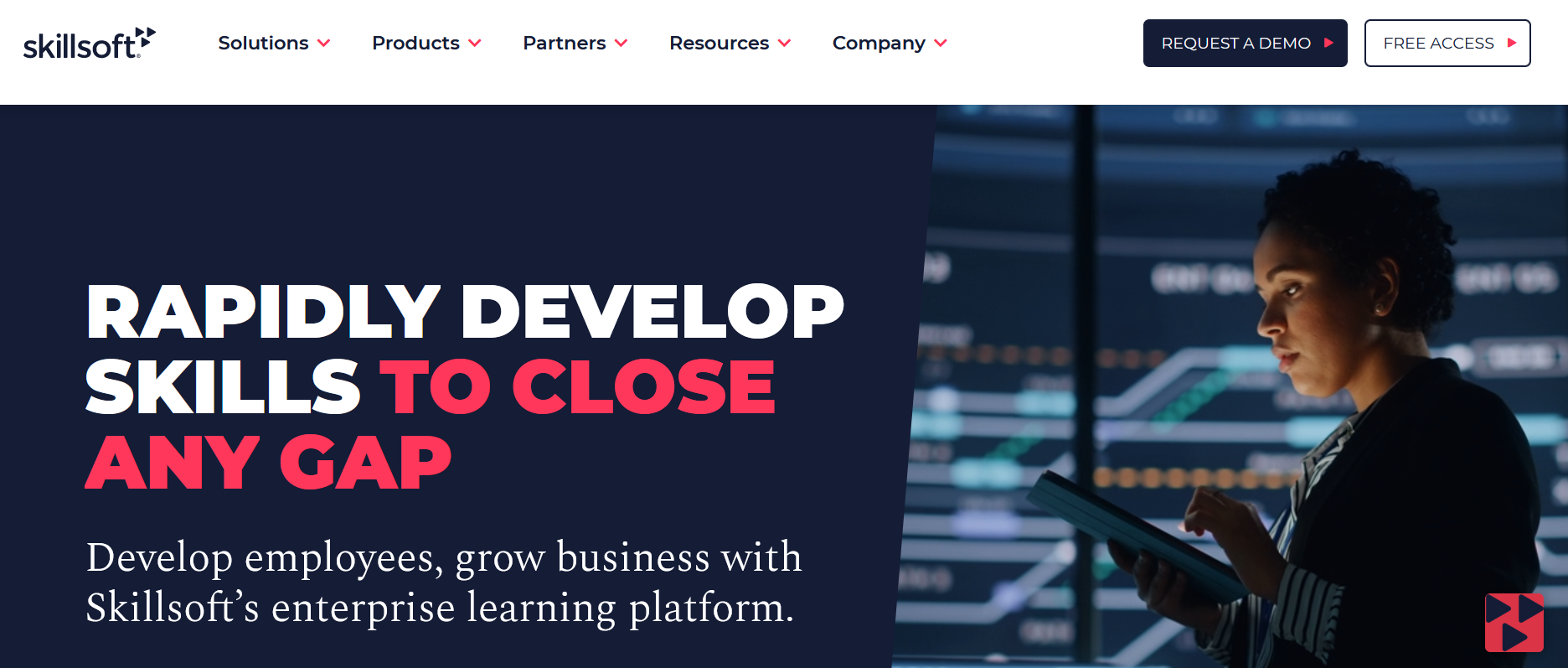
Skillsoft is an online learning platform that provides training and upskilling courses for the workplace. Skillsoft isn’t open to all teachers–potential instructors need to apply for an open role in their Careers section–but they’ve also grown courses by acquiring other companies like Codecademy.
Pros
Lots of different learning and development opportunities in a mix of formats: asynchronous courses, virtual instructor-led training, etc.
An AI-conversation platform to train real-life skills with practice sessions (e.g. reprimanding an employee or leading a meeting).
Personalized course selections and learning pathways that allow learners to go at their own pace.
Skills benchmarking for setting learning goals and KPIs.
Cons
The platform is well-branded, but the interface can be dated at times.
Institutions report challenges with institutional membership setup – it can be complicated and the dashboard isn’t ideal for multiple learners.
Users report that some of the content is quite dry to watch, and it’s missing some of the engagement features you’d hope for.
Best features The courses and content are in line with other platforms, but the AI conversation engine is a really useful tool
Pricing & payouts
Varies by institution and features
11. DataCamp
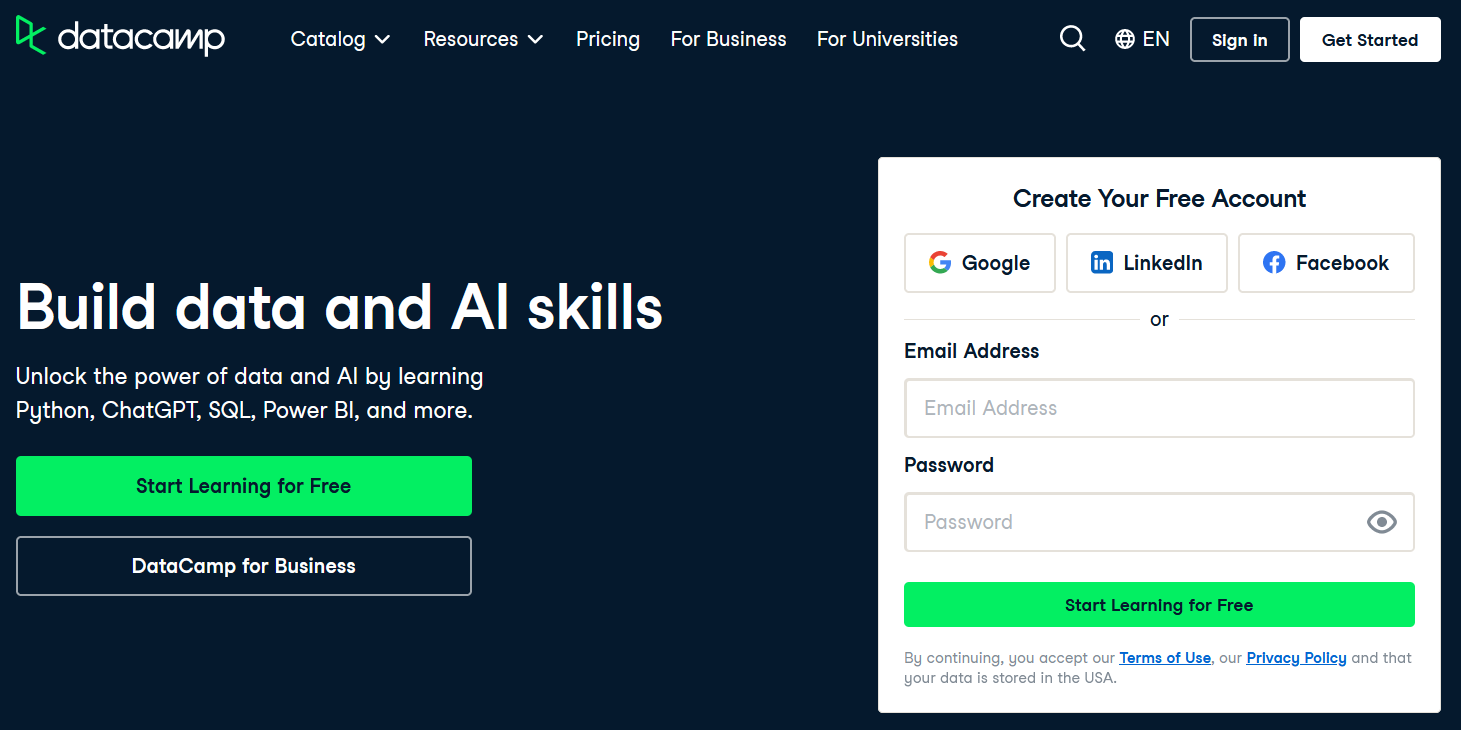
DataCamp is an online learning platform that specializes in data science and AI courses, with training in things like Python, R, SQL, ChatGPT, Tableau, Power BI, and more. DataCamp maintains a list of content they’re actively looking to hire for. If you’re an instructor with technical coding skills, it might be a good spot to teach.
Pros
It has a hands-on approach to learning how to code and is project-based.
Courses at all different levels from beginner to advanced.
Curated learning paths for different careers and knowledge goals
Assessments and certifications are built in.
The mobile apps work great.
Cons
Users report that skills assessments aren’t always accurate and there have been some complaints of outdated courses.
Same problems for teachers as any marketplace–you lose ownership and you’re not building your personal brand.
Best for Students wanting to learn specific data science skills and instructors with deep expertise in a field DataCamp is looking to hire for.
Pricing and payouts For students:
Free - Basic access
$25/mo - Individual access to all courses
Enterprise pricing is available too
Teachers are hired to teach a specific course. Compensation details aren’t publicly available.
Top Online Learning Software
In the next section, we’ll talk about online learning software. This is software that lets you build your online learning platform – under your brand. You won’t get access to the marketplace of users, but building with online learning software often means higher profit margins and more control over your course.
This section is only relevant to instructors.
Here’s what to look for in online learning software:
Tools for building a course, delivering content, and assessing students’ progress
Content delivery options that fit your intended teaching style (e.g. pre-recorded or live courses? Discussions? Live events?)
Options for creating a business around your course
AI features and integration
Integrated tools like websites or communities (according to your needs)
12. Kajabi
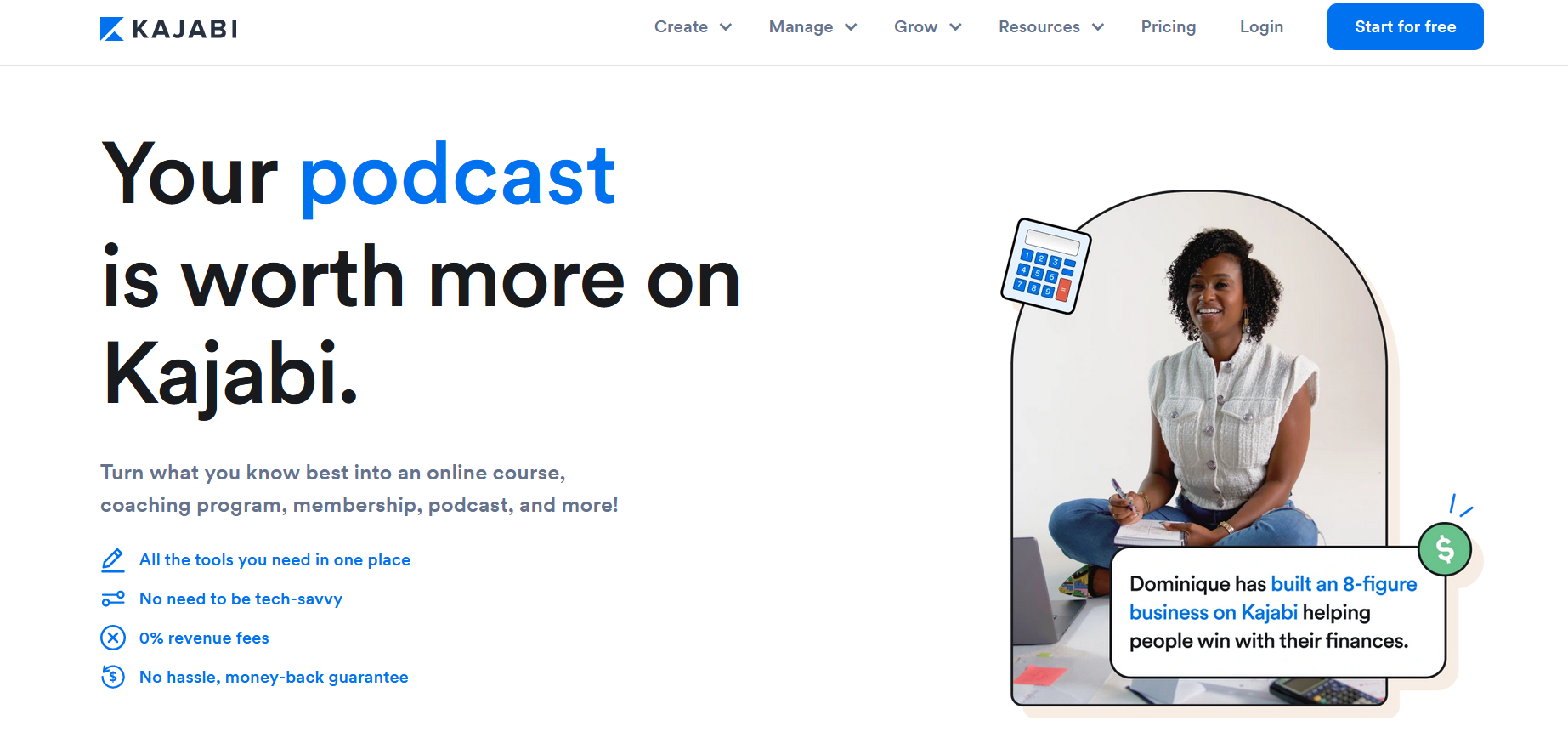
Kajabi is an online learning software that works well for pre-recorded courses. It has the tools to build a course website, some drag-and-drop options for customizing the course, and ways to build in assessment.
Kajabi’s strongest feature is its suite of course marketing tools that let instructors connect their sales to complex course sales funnels. And it also connects to an email tool that’s great for automating your course-related emails.
Pros
A flexible LMS for delivering asynchronous courses
Website-building options with a powerful suite of complex marketing features for funnels, upsells, downsells, etc.
Integrated email to help reach and sell to your course members, including segmentation and cart recovery
Sell one-time fees, memberships, or bundles with preset marketing funnels and templates
Some options for customizing the look and feel of your course
Use detailed analytics to see what’s working and what isn’t
Cons
Limited tools for engagement. The “Kajabi Community 2.0” tool has livestreaming and discussions but is a different platform with separate logins
Difficult to do live courses without resorting to a separate platform
Video is still hosted on a third-party platform (Wistia)
One of the most expensive course platforms on the market
No option to grow into course apps under your own brand
Best features Kajabi is a great tool for someone selling a pre-recorded (asynchronous) course and looking for complex marketing features.
Pricing & Payouts Here’s the Kajabi pricing on a monthly plan
Basic plan - $149/mo
Growth plan - $199/mo
Pro plan - $399/mo
13. Learnworlds

LearnWorlds is a relatively new online learning software, but the creators have combined a powerful website builder with a solid LMS for teaching.
Pros
Good course builder with AI enhancements, lots of learning and content options, SCORM compliance, and flexible delivery options (e.g. drip, custom paths, etc.).
Easy-to-use website builder with SEO-optimization built-in and lots of templates.
Integrated marketing tools, funnels, pricing options, affiliate program, etc. Sell individual courses or bundles.
Mobile app development and editing.
Cohort teaching options for live sessions.
Cons
Extremely basic community feature that isn’t much more than a message board.
Users building websites report limitations with features and customization when compared to a proper website builder.
Many of the most popular features are only available on the most expensive plans.
The marketing features are basic, it’s missing a fully integrated email option and more advanced marketing systems.
Best features A convenient website builder and integrated course platform with some useful marketing features built in. Easy UX and lots of handy features.
Pricing & Payouts
Starter - $24/mo
Pro - $79/mo
Learning Center - $249/mo
14. Thinkific

Thinkific is an online learning platform that gives you useful tools to build and sell your course, things like customizable landing pages, hosting and distributing courses, lots of good course content options, and assessment features.
You can also livestream a course on Thinkific with the Zoom integration, but it’s not built for live teaching either.
It works best for pre-recorded courses with marketing and some simple engagement features.
Pros
Solid LMS with good options to build and customize course content.
Drag-and-drop website builder with lots of templates to choose from for adding sales pages to your course.
Some simple engagement tools to build a community feel.
Integrated ecommerce tools for email marketing, sales and reporting, coupons and subscriptions, and affiliate marketing.
Sell memberships or one-time access to courses
Integrate certificates with quizzes, assignments, and exams to track progress and add credentials.
Thinkific’s own app store offers 80 integrations with other popular tools for sales, marketing, and member management.
Cons
Engagement features are really basic. Very basic discussion and community features
There is no native livestreaming.
They recently added apps, but the apps are plagued by glitches and complaints (2.1 stars on the App Store & 2.6 stars on the Google Play Store).
Best features Thinkific is good for a standalone course that’s pre-recorded or for a program, as long as they don’t require too much engagement between instructors and learners.
Pricing & Payouts Here are the basic plans Thinkific offers
Free plan - A great option to start a course and test the waters
Basic plan - $39/mo
Pro plan - $79/mo
Premier plan - $399/mo
15. Teachable

Teachable is a well-known online learning software that’s built specifically for asynchronous courses. It’s been around for a long time, but the product hasn’t evolved much. It still doesn’t have an Android app, and still doesn’t give any other ways of teaching apart from asynchronous courses.
Teachable has a bit more flexibility in design options than Kajabi or Thinkific.
Pros
Well-designed LMS with flexible content options (comparable to the others on this list)
Good marketing features–including an affiliate program
Course landing pages that are easy to customize and brand
Lots of options to integrate with different tools and software
Cons
No way to teach live courses
No engagement features like discussion forums, events, etc.
No Android apps (leaving out 70% of mobile users)
Best features Thinkific’s best feature is probably its affiliate feature, which lets teachers incentivize others to sell courses.
16. Podia
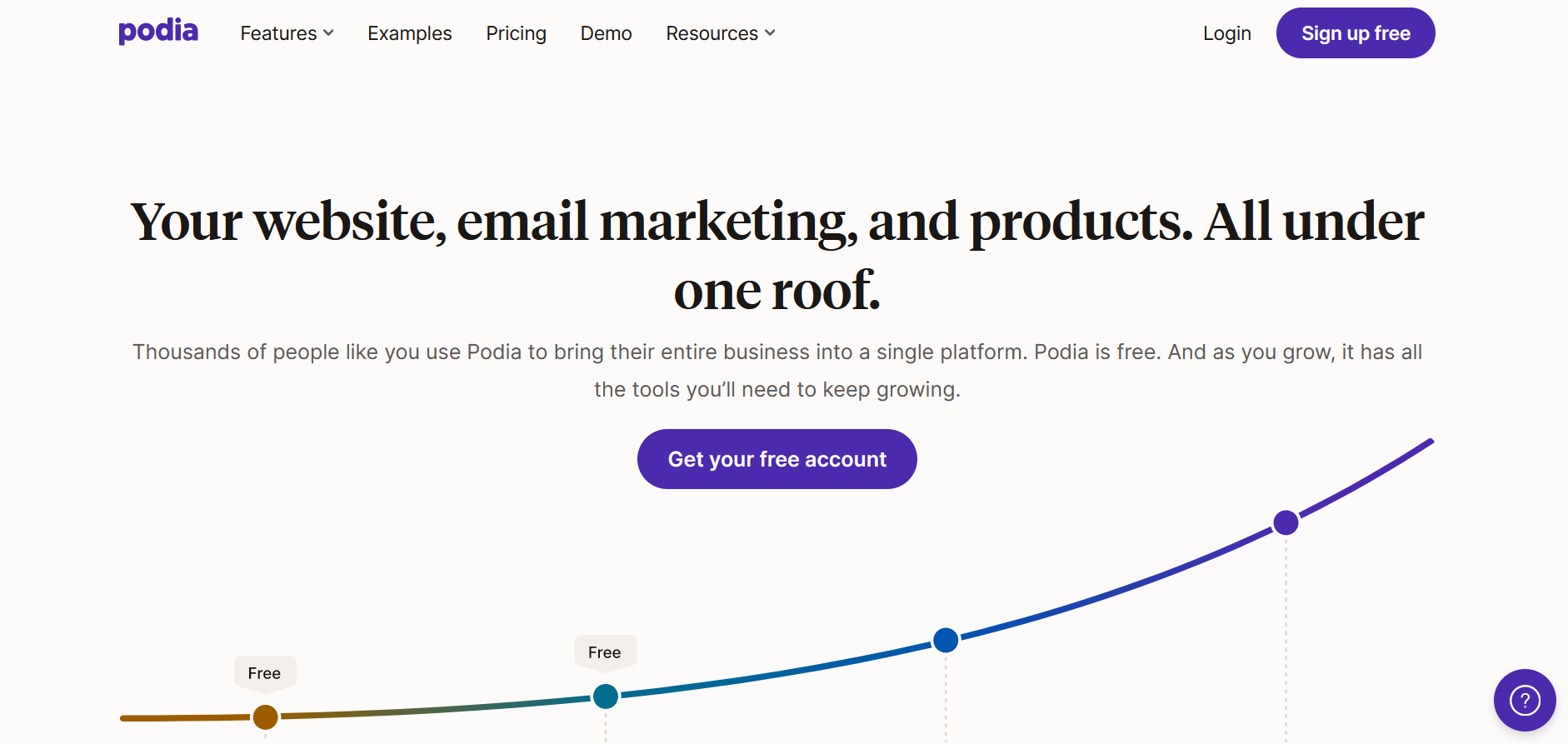
Podia (formerly coach) is a website building software that comes with an online learning software that gives capability for teaching courses. The user chooses a “product” to create: an online course, digital download, webinar, etc., and can then create and sell that product.
Podia comes complete with integrated email and marketing features. None of Podia’s features are exceptional, but the combination of tools makes it feel a bit like a more basic version of Kajabi.
Pros
A good website builder that feels a bit like a Wix or Squarespace with lots of templates to choose from.
The option to integrate products like online courses or online communities.
Marketing tools for building lead magnets, newsletters, campaigns, and landing pages
Sell courses or bundle with other features (e.g. community or coaching)
Flexible course-building tools for modules, lessons, quizzes, etc.
Cons
Every feature is extremely basic; simple email, course-building, etc.
Missing a lot of core e-learning capabilities (grading quizzes, offering certificates, etc).
No mobile apps
Best features The website builder is the best feature–none of the product features are as good as competitors.
Pricing
Free - Basic website + 10% transaction fees on products
Starter - $4/mo + 8% fees on sales
Mover Plan - $39/mo + 5% transaction fees
Shaker Plan - $75/mo (Adds memberships and more customization options)
17. WizIQ
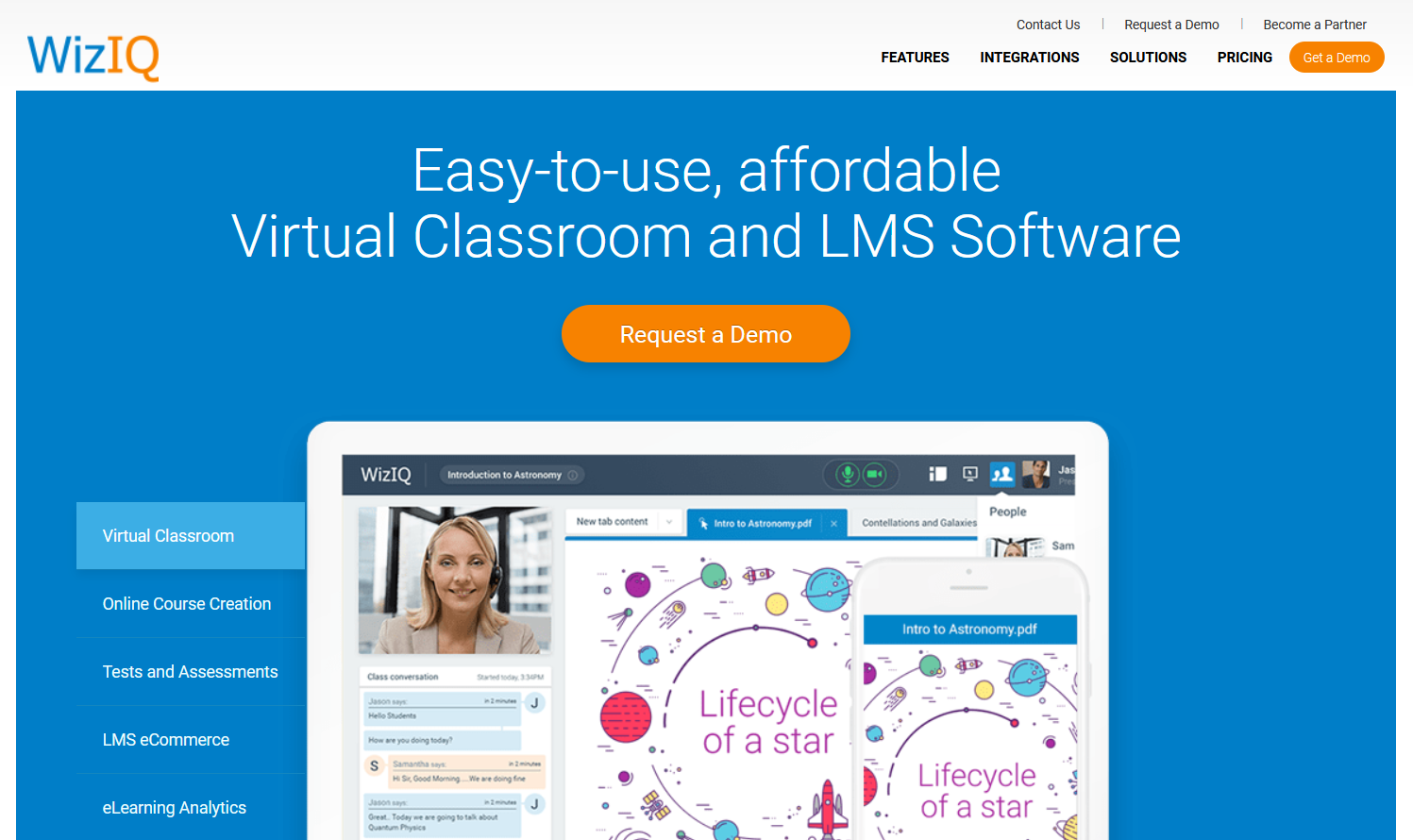
WizIQ is a virtual classroom software and LMS that comes with white-labeling and some good course-building tools. It can be customized for a lot of different online learning uses, but claims expertise with higher ed, government, and corporate training.
Pros
Add tests, assignments, and other LMS features. It can be used for synchronous or asynchronous learning and for creating MOOCs.
Good features like video conferencing, white-board, screen sharing, breakout rooms, and real-time messaging for live participants.
Good data tracking for understanding how learners are using the material.
Courses can be sold too, and there are some hybrid learning tools like the integrated development environment.
Mobile apps for Android and iOS.
Brandable learning portals to have online learning match your brand and tools to create almost any kind of course.
Cons
The branding feels really corporate.
For the complexity of the solution, many customers have said the customer service is lacking.
Quite expensive and the cost grows as you grow – more features and students turn into higher costs and upsells.
It’s not a self-serve online learning software. Every single plan requires meeting with the sales team.
Best features: The flexibility with teaching options is the best feature of WiZIQ, with powerful features for both live and pre-recorded courses.
Pricing
Not available publically
Top Online Learning Plugins
The options we discussed above are all standalone online learning software. But what about those who have built on WordPress? In this section, we’ll cover a few online learning plugins for adapting a WordPress site for teaching.
Remember, these tools can be more complicated and require multiple plugins to get full online learning functionality.
18. LearnDash
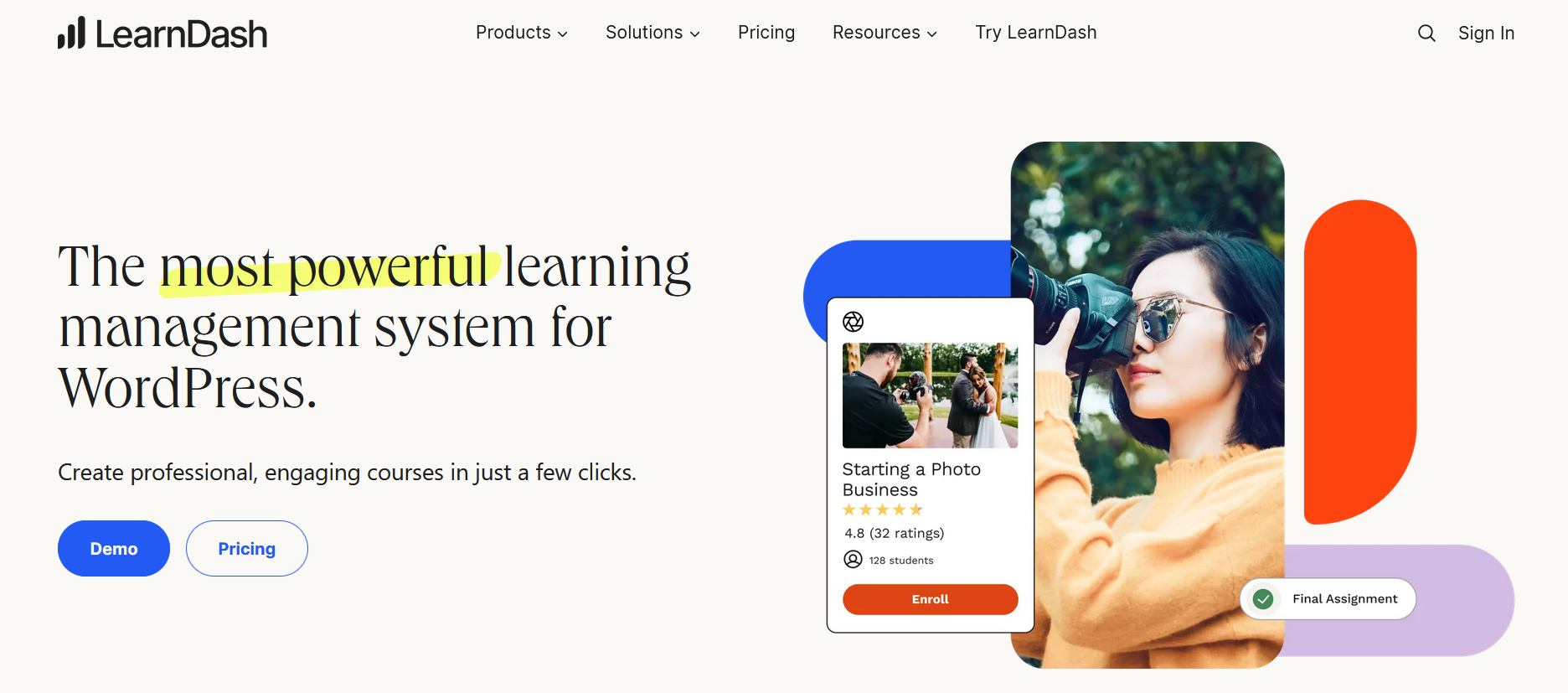
For those wanting a plugin to turn a WordPress site into an online learning software, LearnDash is a good choice. It has a course authoring platform that looks and feels like the Gutenberg editor–it will be familiar to regular WordPress users.
It has a lot of flexibility for setting different course options, building content, dripping lessons, customizing the flow, or even adding assessments or certificates.
The downside is that LearnDash doesn’t have a native payment processor or different engagement options–it needs to be integrated with other plugins to get things like a discussion forum.
LearnDash also recently added membership capabilities with a second plugin called MemberDash that fills out its membership-type features (which were lacking before)
Pros
WordPress compatible LMS that integrates with Gutenberg.
Drag & Drop course builder that has good features like course cloning for duplicating content and a “course creation wizard” to whip up a course from an existing playlist.
Flexible options for course design and delivery with a “Focus mode” to eliminate distractions on the interface.
Badges and certifications to offer learners credentials from your courses.
Advanced quizzing options with 8 question types.
Some e-commerce capability to sell one-time purchases or subscriptions (you’ll need another plugin for more comprehensive payments).
Cons
LearnDash (like most WordPress plugins) can require some custom development to properly get it to match the look and feel of your site.
Comprehensive payments and sales deliveries require a secondary plugin like Easy Digital Downloads. Additional content gating and comprehensive membership features may also require more plugins.
Best features The best feature of LearnDash is simply that it turns your WordPress site into a course platform, with a familiar look and feel to Gutenberg.
Pricing & Payouts
LearnDash LMS Plugin: $199/yr for 1 site
MemberDash Plugin: $199/yr for 1 site
LearnDash Cloud: Starting at $25/mo (billed annually), includes hosting, ProPanel, and additional plugins.
19. MemberPress
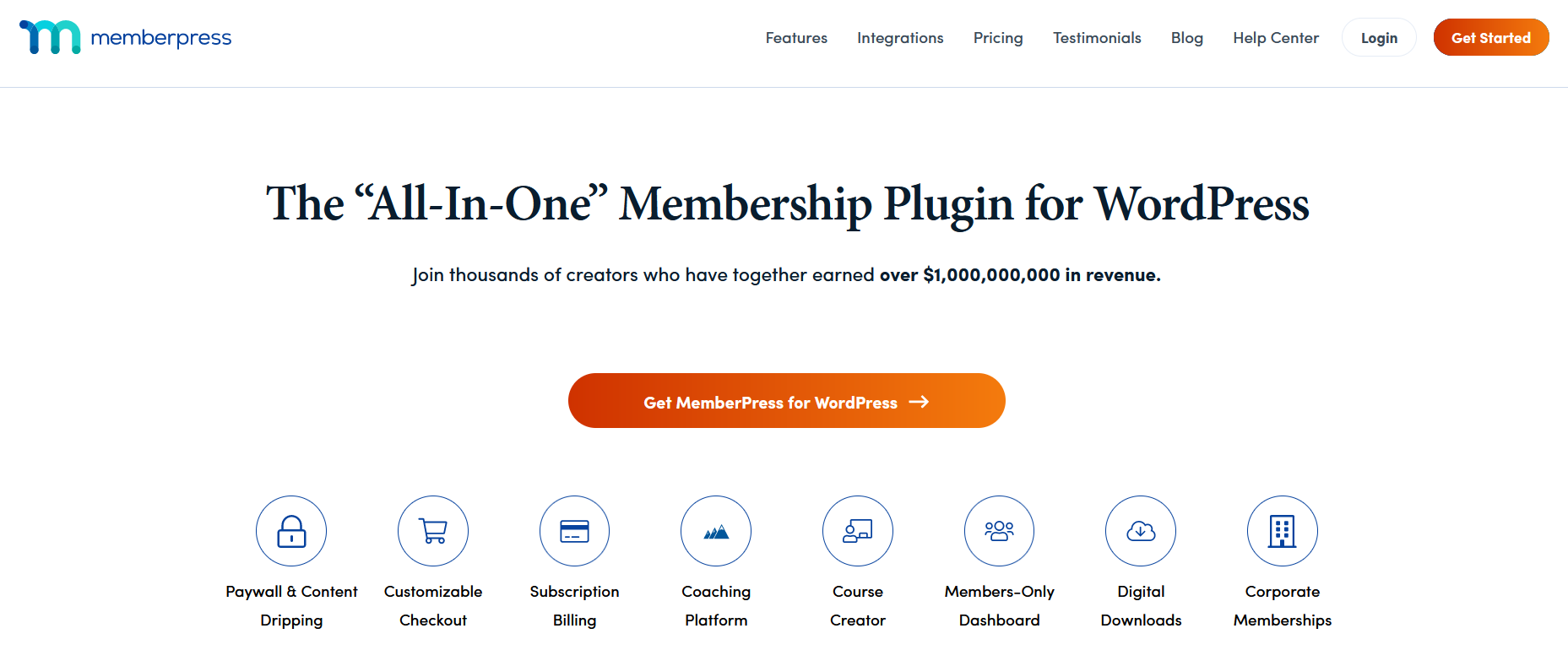
MemberPress is a WordPress plugin that can be used to gate content and–as such–it’s a tool for selling courses. For full functionality, it might need to be integrated with other LMS platforms.
With the MemberPress course add-on, you can integrate course features to the plugin, and we’ll include these in the summary below.
Pros
Different membership functions for gating content with a paywall and creating plans.
Monetize different types of content which could include courses, but isn’t limited to it–and abilities to add exceptions and rules.
Has a forum and community add-on for different types of membership sales.
Flexible sales features like group pricing, coupons, and upsells with tax integration
Customized pricing pages with dynamic tables.
ReadyLaunch™ can quickly create sales and course pages with easy styling.
Visual course builder with a user-friendly interface and content delivery flexibility (e.g. dripping content).
Cons
Requires two different plugins to get a full feature set of an online learning platform.
Dependance on WordPress means that often both UX and customization can be clunky and often require custom development.
Even with two plugins, the platform isn’t nearly as comprehensive as an online learning software.
No mobile apps.
Best features The best features of MemberPress are the fast and easy page building and the comprehensive sales tools.
Pricing & Payouts
Basic plan - $179.50/yr (Basic membership and course functions)
Plus plan - $299.50/yr adds quizzes & certifications and more marketing features
Pro plan - $399.50
Elite plan - $499.50
20. Memberful
Memberful is another WordPress plugin option that can integrate with an online learning plugin like LearnDash to sell an online course. Since not every WordPress LMS comes with good payment options (or any), Memberful can be a useful monetization tool – a membership and checkout plugin for WordPress.
Pros
Fairly easy to set up and deploy.
Gives you a flexible checkout that integrates with Apple Pay and Good Play, adding free or paid trials, coupons, and discounts
Can be used as a standalone monetization tool (although it makes more sense integrated with WordPress)
Branding options to add custom colors, logos, checkouts, and even white-labelling.
Manage subscriptions and members.
Cons
Requires multiple plugins to get the course functionality
It’s basically just a content gate function
The UX between Memberful + whatever LMS plugin you choose can be clunky
Really expensive transaction fees
Best feature Turning a course plugin like LearnDash into a comprehensive course business.
Pricing
Starter plan - Free + 10% transaction fees
Pro plan - $25/mo + 4.9% transaction fees
Premium plan - $100/mo + 4.9% transaction fees
Institutional Online Learning Platforms
We’re going to close out this post by including some institutional online learning platforms. While there’s crossover with many of the features of platforms on this list, institutional online learning platforms have different needs:
Many require an in-house tech team to handle customization, interoperability, etc.
Most will function in a tech stack, as opposed to the standalone online learning software above.
They prioritize different things, usually this includes more complex grading and admin features and they don’t need monetization and marketing features.
21. Moodle

Moodle is an open-source online learning management system that comes built with an option to lay out courses and add lessons and modules, and incorporate a variety of content. But many institutions choose Moodle for its customizability; it gives your IT team the flexibility to make it fit your use case.
Pros
Integrated engagement features like discussion forums, p2p-learning, group projects, collaboration tools, announcements, and messaging.
Create and assign complex quizzes, essays, peer-assessments, and calculate grades.
There are several different themes to work with, or you can custom-build one. The dashboards are also customizable and can be rearranged for different needs.
Good apps that can be used to deliver content, notifications, and host discussions.
API support for integrating Moodle with third-party applications or plugins.
Cons
Extremely high need for competence if customizing – best for institutions with ongoing developer support. Initial setup is complicated and time-consuming.
Administrators often need training to use the platform – it’s not necessarily intuitive and the UX is complicated to learn.
Customization is often dependent on third-party plugins which add cost and complexity.
The mobile app is missing some of the features of Moodle’s web system.
Best features Highly customizable open-source learning management system that is good for institutional learning.
Price
Free (but will need integrated plugins, hosting, etc.)
22. Canvas
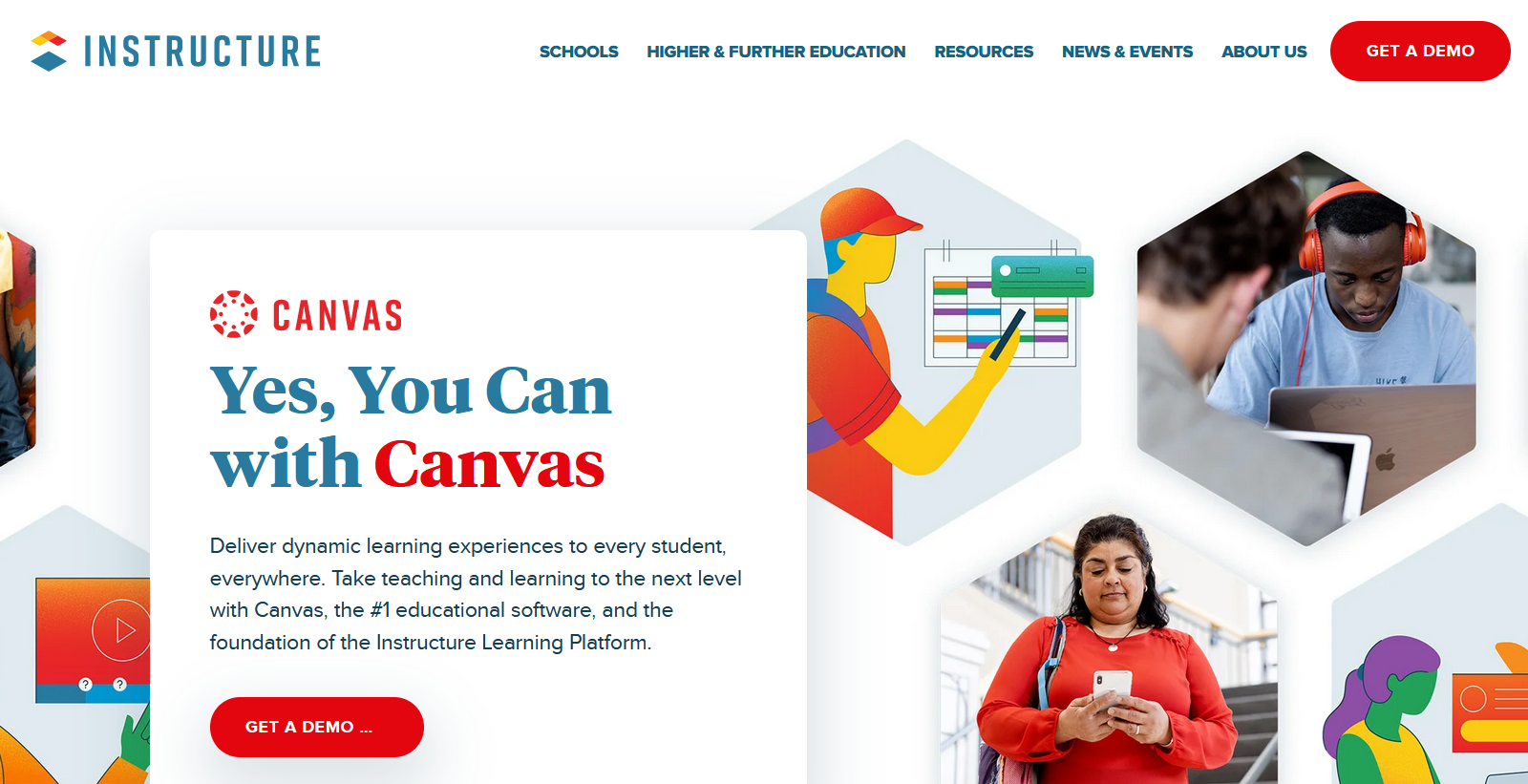
Canvas is a cloud-based online learning software that provides an LMS for K-12, higher ed, and corporate applications. It can be used to create an entire digital learning hub with multiple stakeholders: students, teachers, and administrators.
Pros
A versatile and powerful LMS that includes authoring software, assessments, and credentials. Can be customized with rubrics, calendars, quizzes, assessments, and analytics.
It was built for Learning Tools Operability (LTI compatible) and integrates with 200 other tools and apps.
Lots of collaborative engagement tools like communications, audio notes, messaging, and collaboration features.
Mobile apps that work well for all devices.
Cons
Despite the flexibility, many institutional clients have complained about features that are missing: from customization options to tools. There can also be a slow rollout time between new features being released and when they are incorporated into institutions’ packages.
Reports of the software being glitchy, and specifically awarding credits and points on account of these glitches.
Not enough interactive and engagement-building features.
Best features A well-known institutional LMS that meets the standards for LTI interoperability.
Pricing
Customized for each institution
23. Blackboard
Blackboard Learn is an LMS for online learning that is commonly used by educational institutions to deliver content, host discussions, and share progress and grades.
Pros
Good tools for creating course content, including customizable course structure, modules, assignments, and assessments.
Collaboration and engagement features like discussion boards and forums with announcements and notifications built-in.
The Blackboard Collaborate tool can host live meetings like study sessions and office hours.
Easy-to-use dashboard for students including grades and digital submission.
Cons
The design and feel of Blackboard can appear dated sometimes.
Some institutions report a lack of customization at the instructor level (instructors are bound to the features available to the whole institution).
Steep learning curve for new users.
The mobile apps are functional, but have UX issues.
Occasional outages on Blackboard create system-wide chaos.
Best features A full set of tools for institutional users with in-house IT wanting a recognizable and scalable learning management system.
Pricing & Payouts
Varies
Branded online learning app software
24. Mighty Pro
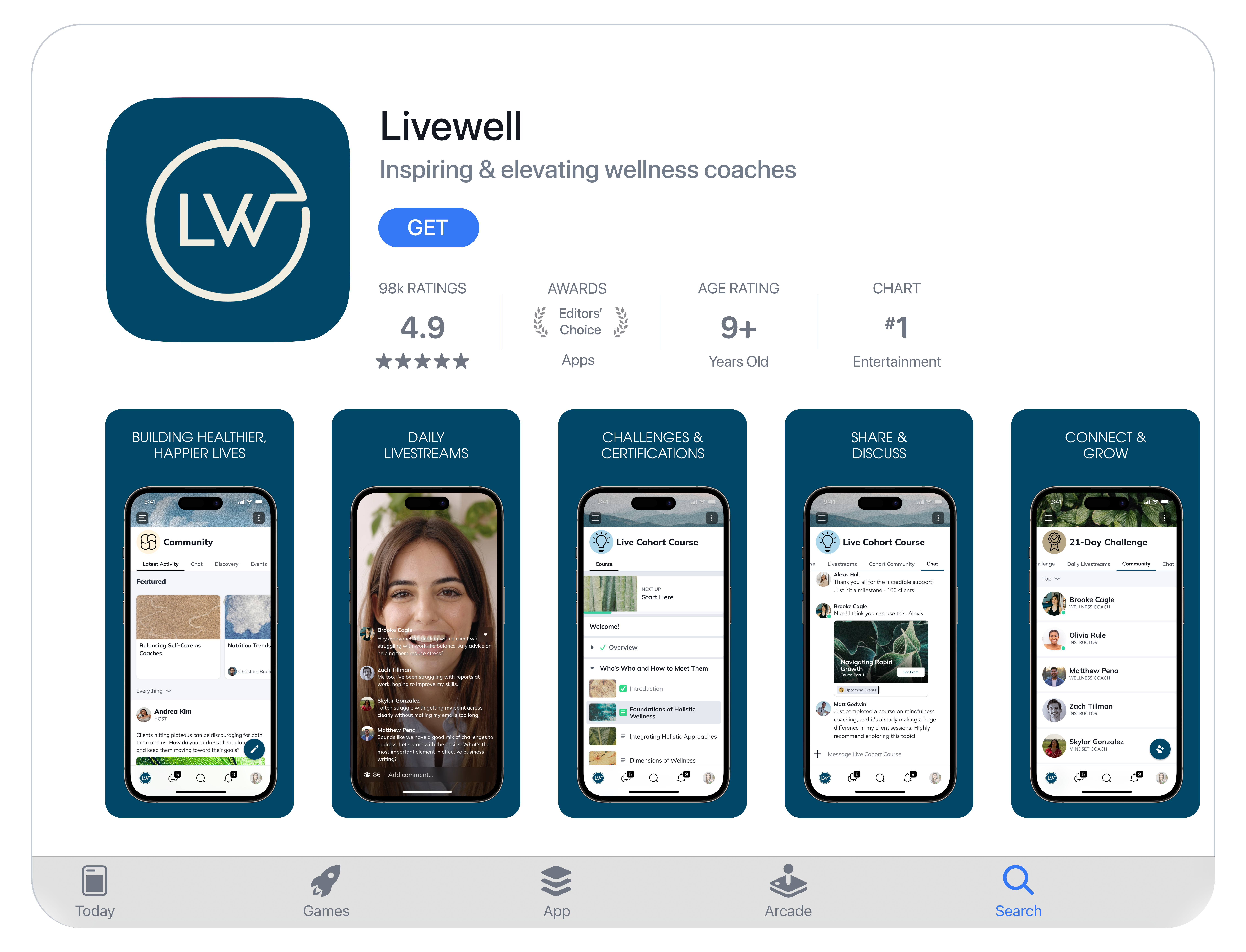
If you’re with an institution or brand, or you’re an established creator looking for an online learning app under your own brand, Mighty Pro gives you your own courses and deploys them on a branded app in the App Store and Google Play Store.
It’s YOUR brand’s app, not someone else’s.
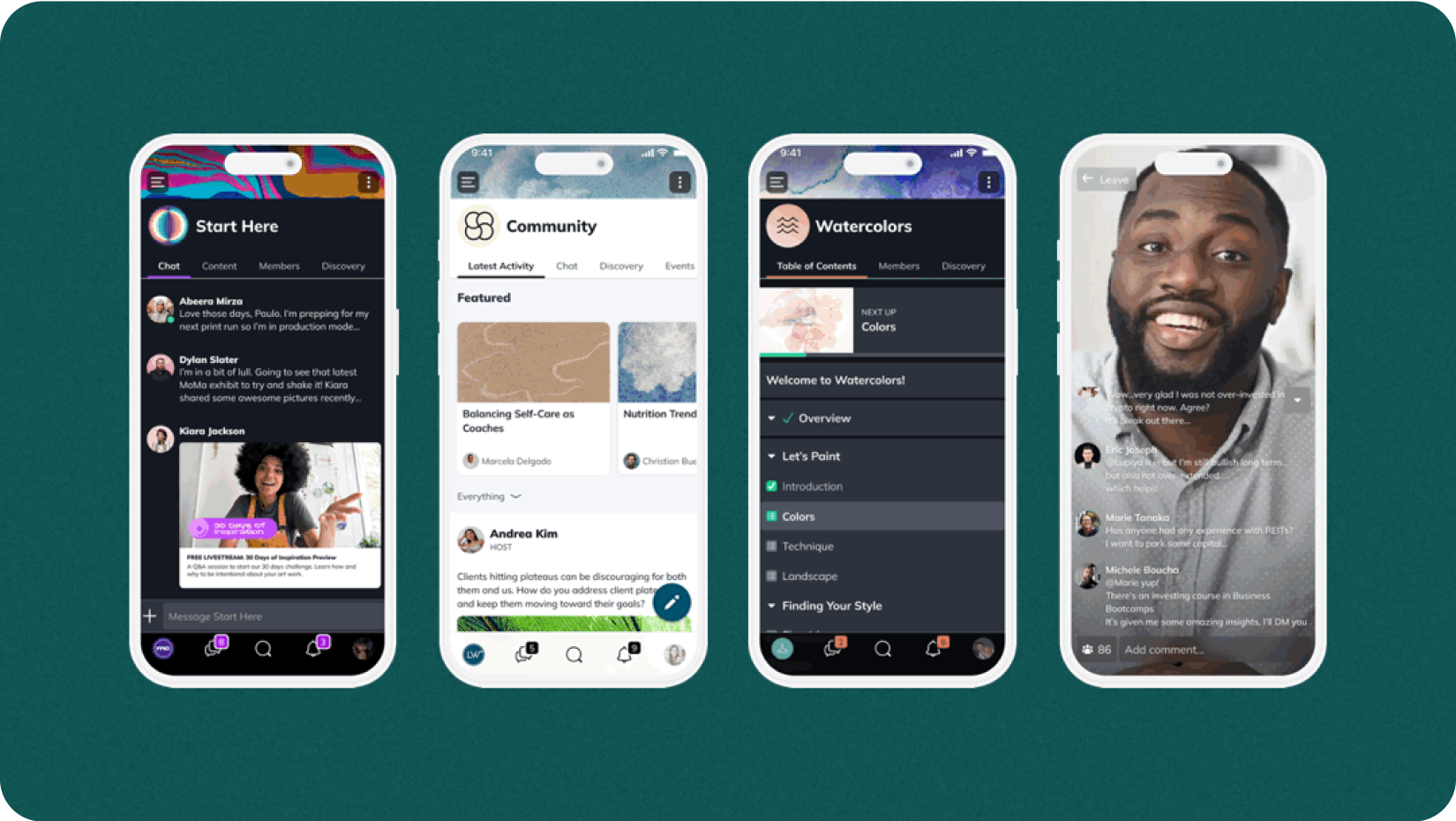
Pros
A powerful LMS under your own brand, with a full suite of content options and assessment tools.
Engagement tools like no other with G2’s top-rated community platform, includes discussions, chat, messaging, events, livestreaming, and more.
Teach live, pre-recorded, or a mixture of both.
Integrated AI tools with Mighty Co-Host™ means instant course outlines, help with writing, member management tools, the Infinite Question Engine, and more.
Proactive submissions for updates and ongoing VIP support.
Cons
Mighty Pro is best for established brands, institutions, and creators.

Ready to start?
We’ve covered a lot here, but hopefully you’ve got a better understanding of online learning platforms and which is the right one for you!
And if you want to build on Mighty, come give our course software a try! It’s free for 14 days, and we won’t ask for a credit card for the trial.
What is an online learning platform?
So what is an online learning platform?
For teachers, an online learning platform is a content delivery system that lets you create and host online courses: delivering course content, performing assessments, and integrating other learning management features like sales options, student engagement and communication features, and more.
The “platform” part usually means that it’s a place that hosts multiple other courses from other teachers.
For students, an online learning platform is a method of digital course delivery.
There are two choices:
A course marketplace made up of hundreds or thousands of courses, often sold on a subscription model; or
A specific course that’s purchased from individual course instructors
An online learning platform should come with an online learning management system (LMS), ways to create and host content, and tools for communicating with students. If relevant, they also come with monetization features for selling course access.

Online Learning Platforms vs. Online Course Platforms
What’s the difference? Technically, an online learning platform is a space where multiple online courses live. You might think of a course marketplace like Skillshare or Udemy. These let you build and deliver course material and–in some cases–offer assessment and learner feedback. They will also usually compensate a course creator according to their pre-arranged agreements: sometimes creators are paid per course and sometimes they’re paid a portion of the online learning platform’s membership fees.
Sometimes people also use the term “online learning platform” to refer to an online course platform. Unlike an online learning platform, an online course platform isn’t a marketplace. Instead, it gives you software to create an online course that’s all your own, with the hosting and monetization built-in. Usually, online course platforms are self-hosted, meaning you aren’t putting your course up with thousands of others.
We’ll cover some options for both of these below.
Online Learning Platforms vs. Online Course Software: Similarities
Both your online learning platform and online course software probably come with…
E-learning authoring – the option to design course material and deliver it digitally–usually laid out by sections and modules.
Content options - different ways to build and deliver course content (audio, text, video, photos, PDFs, etc.).
Ways to access – course members can access course content through a content gate.
Assessment – a learning needs assessment, so these platforms should come with tools for testing, sharing results, and perhaps accreditation (if relevant).
Monetization tools – for collecting payments, building bundles, and selling relevant benefits (e.g. discussion groups, coaching, communities).
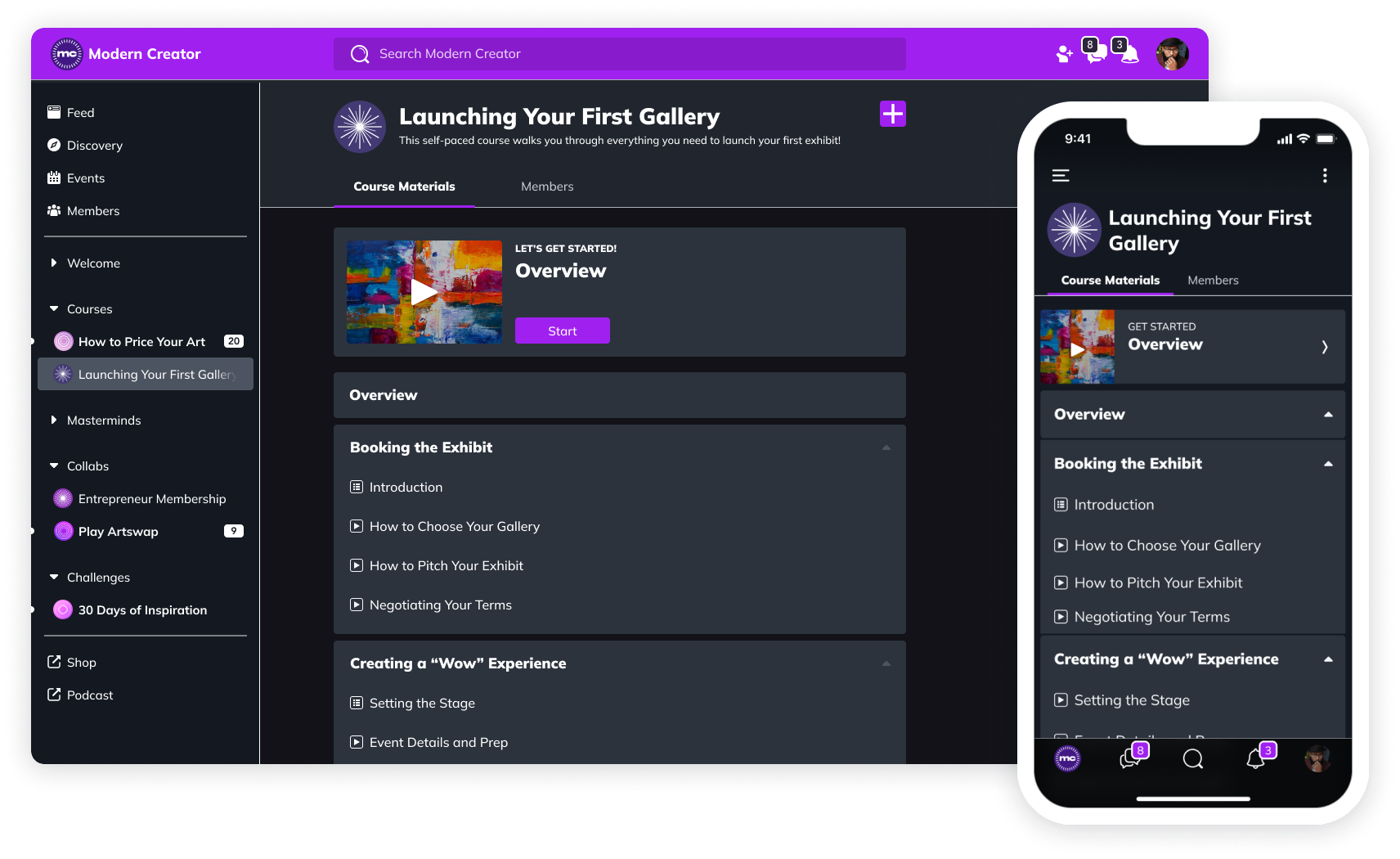
Online Learning Platforms vs. Online Course Software: Differences
Online learning platforms usually have…
Marketplaces or libraries that host multiple courses.
Standardized features and designs for all users.
By contrast, online course software usually comes with:
Options to customize your content and delivery.
Tools to build your own branded course style.
Total control over your connections with students/members.
Different customization tools for assessment, engagement, etc.
Building on online course software usually means more customization, more control, and more profits (since you keep everything you make). But the tradeoff is you need to learn how to market your course to get students in the door.
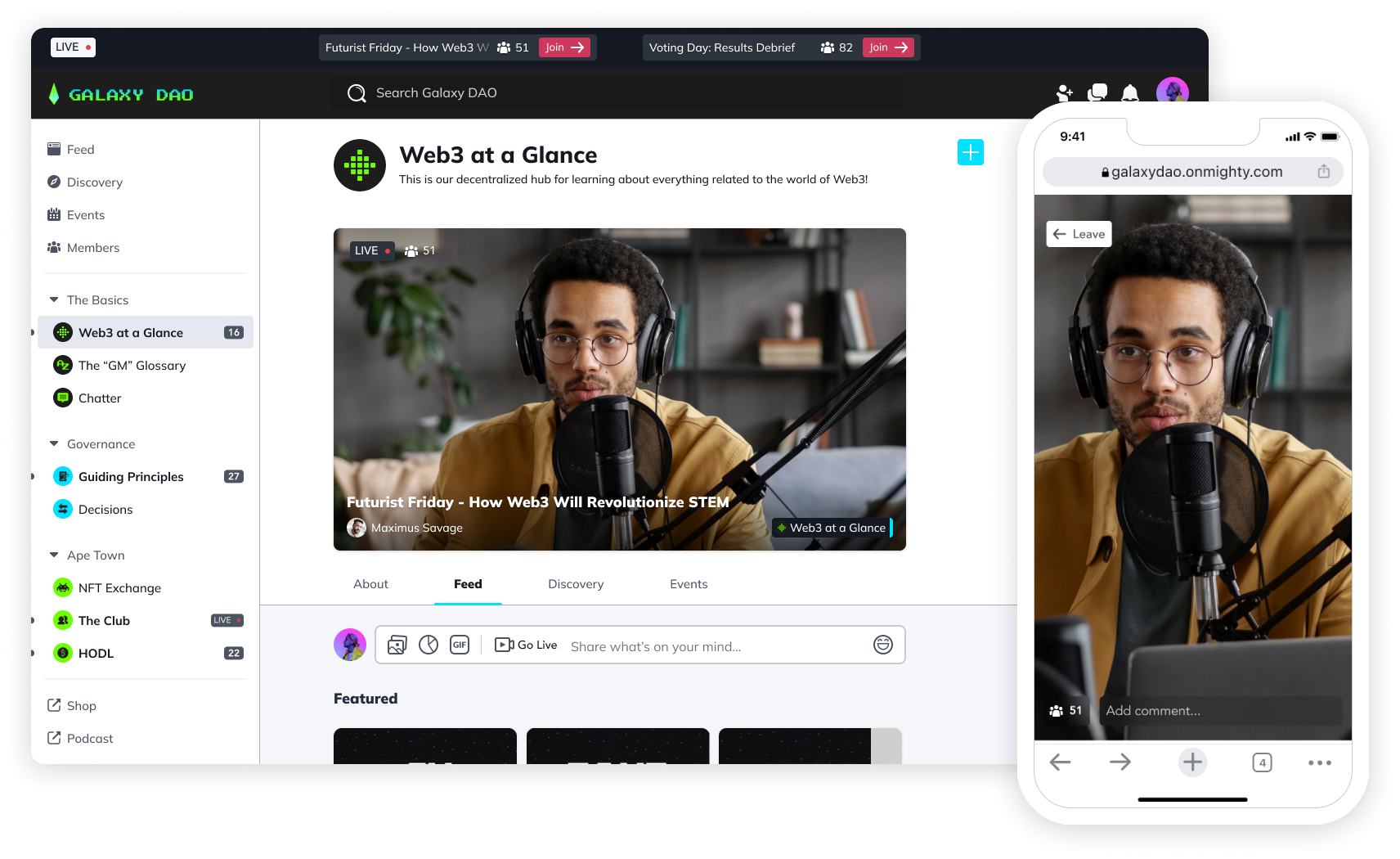
Pros of an online learning platform
For teachers:
Build on a recognized brand with existing customers
Launch to a marketplace of existing learners
Very little to do once your course is live (creates nearly passive income)
The platform takes care of any customer service, technical difficulties, etc.
For learners:
Access a library of tons of courses (often with one membership fee)
Cons of an online learning platform
For teachers:
Usually earn less than with your own course software (some platforms’ revenue share models earn you almost nothing).
You can’t communicate well with students (or sometimes at all) or manage members.
You can’t build your own brand either visually or in terms of brand loyalty.
For learners:
No relationship with teachers and poor learning reinforcement
No accountability and no support = lower completion rates
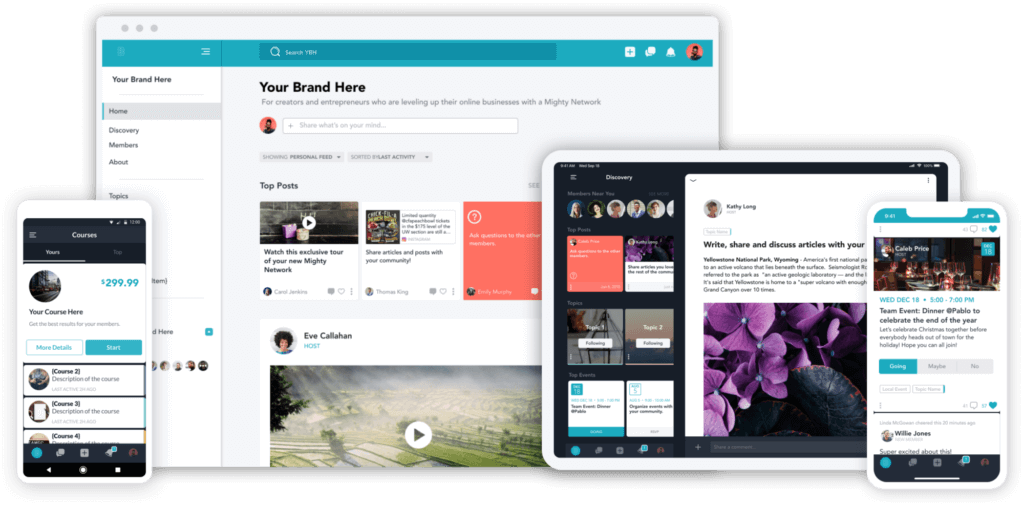
Ready to start building your community?
Start a free 14-day trial to explore Mighty—no credit card required.
More like this
Join Mighty Community
Learn the principles of Community Design™ (and see them in action) alongside thousands of creators and entrepreneurs. It's free to join!

Online Courses
Creating a Course
Teaching a Course
Course Platforms
Selling a Course
Communities & Memberships
Community Platforms
Managing a Community
Building a Community
Growing a Community
Monetizing a Community
Content Creation
Creators & Entrepreneurs
Monetization
Content Creation
Starting a Business
Website Builders
Creating & Managing a Website
Events
Event Platforms
Hosting & Marketing Events
Branded Apps
Creating a Mobile App
Coaching Apps
Community Apps
Coaching
Mastermind Groups
Starting a Coaching Business
Coaching Platforms
Filter by Category
Online Courses
Communities & Memberships
Creators & Entrepreneurs
Events
Branded Apps
Coaching
Start your free trial
14 Days. No Credit Card Required.








